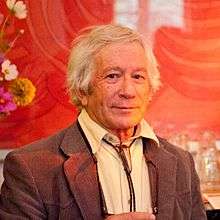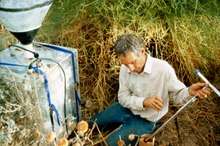Mark Nelson (scientist)
| Mark Nelson | |
|---|---|
 Nelson chairing the 2011 Institute of Ecotechnics Mediterranean conference, Les Marronniers, Aix-en-Provence, France. | |
| Born |
1947 Brooklyn, New York |
| Education |
|
| Occupation | ecologist, author |
Mark Nelson (born 1947) is an American ecologist and author based in Santa Fe, New Mexico. His research focuses on closed ecological system research, ecological engineering, restoration of damaged ecosystems, and wastewater recycling. One of the founding directors of the Institute of Ecotechnics in 1973, Nelson was one of the eight original crew members of Biosphere 2 for its two year closure experiment 1991-93 and served as the Director of Earth and Space Applications for the project until 1994. He founded and is the principal of Wastewater Gardens International to apply constructed wetlands for sewage treatment worldwide and helps research and manage several ecotechnic field projects.
Life and career
Nelson was born in Brooklyn, New York. He majored in philosophy and pre-med sciences at Dartmouth College and received his BA summa cum laude in 1968. After a stint in New York City working as social worker and other jobs including taxi driver, he arrived in 1969 at the Synergia Ranch in New Mexico. The ranch, named for the concept of synergy popularized by Buckminster Fuller, was founded by a group of people including John Allen and owned by Marie Harding.
The Institute of Ecotechnics was founded in 1973 with Nelson as its initial chairman.[1] Synergia Ranch was the Institute’s first field project with the goal to reverse a history of land degradation by extensive planting of trees, soil building and check dams. Nelson has managed the organic vegetable gardens and orchards which were originally planted in the 1970s, In 2016, Synergia Ranch won the Good Earth Award at the New Mexico Organic Farming Conference.[2] At Synergia Ranch, people worked in three areas: ecology, enterprise (to be self-supporting) and theater (the Theater of All Possibilities was based there and performed locally and toured the US and Europe).[3]
The Institute of Ecotechnics, which set its goal as harmonizing the worlds of technology and ecology, is now registered in the U.K. and the U.S. and consults to a series of projects around the world including Birdwood Downs in northern West Australia, Las Casas de la Selva in Puerto Rico and the RV Heraclitus, an ocean going ferrocement sailing ship[4]., Ed Bass, who funded the Biosphere 2 project was a Director of I.E. for over a decade previously[5]
In 1978, Nelson helped start the Institute of Ecotechnics' 4300 acre tropical savannah project, Birdwood Downs, serving as its first General Manager. The project focuses on pasture regeneration and ecological restoration.[6] Robyn Tredwell, the project’s manager from 1985-2012, was selected as Australia’s first Rural Woman of the Year.[7]
In 1986, Nelson and John Allen co-authored Space Biospheres, which outlined the plans for the man-made minibiosphere and some of its scientific rationale.[8] Nelson was one of the original eight crew members who remained in the closed environment of the Biosphere from 1991 until 1993 and was responsible for the constructed wetland wastewater system as well as working on animal fodder, wilderness biomes research, and served as Communications Officer during the first closure experiment.[9][10][11]
After the initial Biosphere 2 experiment ended in 1993, Nelson and his fellow crew member Abigail Alling published Life Under Glass: The Inside Story of Biosphere.[1] Nelson then began graduate studies at the University of Arizona's School of Renewable Natural Resources, receiving his MSc in 1995.[12] In the interim, disputes over the management of the next phase of the Biosphere project in 1994 had led to its financial backer Ed Bass placing the project into temporary receivership and relieving the project's chief management of their duties, including Nelson who was the Director of Earth and Space Applications.[13] Nelson went on to study environmental engineering science under Howard T. Odum at the University of Florida's Center for Wetlands, and received his PhD in 1998 with a dissertation entitled Limestone wetland mesocosm for recycling saline wastewater in coastal Yucatan, Mexico.[14]
Nelson helped develop the research program for an I.E.-consulted project, Las Casas de la Selva, in Puerto which works on sustainable forestry in the wet tropics. Between 1985-1990, 40,000 valuable hardwood tree seedlings were planted on one-third of a 1000 acre mountain area of secondary forest.[15] With the help of Earthwatch Institute volunteers from 2001-2015, research was conducted and published on these alternatives to clear-cutting and conversion of forest to agriculture.[16] The ecotechnic project was recognized for its innovative approaches to tropical forestry with the 2016 Energy Globe national award for Puerto Rico.[17]
He is also the founder and principal of Wastewater Gardens International (WWG-I), a company which develops and promotes constructed wetlands.[18][19] First working with the Biosphere Foundation, Nelson developed biodiverse subsurface flow wetlands for applications in Puerto Rico, Mexico and Indonesia. WWG-I has built over 150 systems in 14 countries, including the first in Algeria.[20]

Nelson remains the Chairman of the Institute of Ecotechnics (having resumed the post in 1982 after a seven-year period when it was run by Randall Gibson).[1] He organizes sessions for COSPAR (International Committee on Space Research, ICSU) on closed systems and space habitation[21] and serves as Associate Editor of the journal, Life Sciences in Space Research (LSSR).[22] Nelson continues to publish papers on ecosystem research and engineering in journals such as LSSR, Advances in Space Research and Ecological Engineering.
Publications
Nelson's publications include:
- Nelson, M., publication in 2018. Pushing our Limits: Insights from Biosphere 2, University of Arizona Press. https://uapress.arizona.edu/book/pushing-our-limits
- Nelson, M., K. Gray and J.P. Allen, 2015. Group dynamics challenges: Insights from Biosphere 2, Life Sciences in Space Research 6 (2015):79-86. https://dx.doi.org/10.1016/j.lssr.2015.07.003
- Nelson, Mark (2014). The Wastewater Gardener: Preserving the Planet One Flush at a Time. Santa Fe, NM: Synergetic Press. ISBN 9780907791515. www.wastewatergardener.com
- Nelson M., Cattin F., (2014). "Greening the Planet". World Water, Volume 37 (pp. 22–23, 49), Issue 4, July/August 2014.
- Nelson, M., S. Silverstone, K.C. Reiss, T. Vakil and M. Robertson, 2011. Enriched secondary subtropical forest through line-planting for sustainable timber production in Puerto Rico, Bois et Forêts des Tropiques 309 (3): 51-63. bft.cirad.fr/cd/BFT_309_51-61.pdf
- Nelson, M., W. Dempster, J. Allen, (2013). "Key Ecological Challenges for Closed Systems Facilities". Advances in Space Research (2013) doi:10.1016/j.asr.2013.03.019
- Nelson, M., and Wolverton, B.C. (2011). "Plants + Soil/Wetland Microbes: Food Crop Systems that also Clean Air and Water". Advances in Space Research (2011) doi:10.1016/j.asr.2010.10.007
- Nelson, M., N.S. Pechurkin, J. Allen, L.A. Somova and J.I. Gitelson (2010). "Bioengineering of Closed Ecological Systems for Ecological Research, Space Life Support and the Science of Biospherics" in (eds. L. K. Wang, V. Ivanov and J.H. Tay) The Handbook of Environmental Engineering series, (10), 11. The Humana Press, Totowa, NJ.
- Nelson M., Cattin F., M. Rajendran, INRA, (2008). "Value-adding through creation of high diversity gardens and ecoscapes in subsurface flow constructed wetlands: Case studies in Algeria and Australia of Wastewater Gardens systems". IIth International Conference on Wetland Systems for Water Pollution Control, Indore, India, International Water Association (IWA), Vikram University IEMPS, ICWST, November 2008.
- Nelson, M., R. Tredwell, A. Czech, G. Depuy, M. Suraja and F. Cattin, 2006. Worldwide Applications of Wastewater Gardens and Ecoscaping: Decentralized Systems which transform Sewage from Problem to Productive, Sustainable Resource, in (eds. K. Mathew, S. Dallas, G. Ho). Decentralized Water and Wastewater Systems: International Conference, Fremantle, Western Australia, pp. 63–73. July 10–12, 2006. IWA Publications, London. http://www.wastewatergardens.com/pdf/2006_MURDOCHWorldWApp.pdf
- Nelson, M., 1998. Wetland Systems for Bioregenerative Reclamation of Wastewater—from Closed Systems to Developing Countries. Life Support and Biosphere Science 5 (3): 357-369. https://www.researchgate.net/profile/Mark_Nelson9/publication/11486899_Wetland_systems_for_bioregenerative_reclamation_of_wastewater_from_closed_systems_to_developing_countries/links/557856b008aeacff2002811a/Wetland-systems-for-bioregenerative-reclamation-of-wastewater-from-closed-systems-to-developing-countries.pdf
- Nelson, M. (1997). "Bioregenerative Life Support Systems for Space Habitation and Extended Planetary Missions", pp. 315–336 in (ed. Churchill, S.). Fundamentals of Space Life Sciences, Orbit Books
- Nelson, M., T. Burgess, A. Alling N. Alvarez-Romo, W. Dempster, R. Walford, and 1. Allen. 1993. Using a closed ecological system to study Earth's biosphere: Initial results from Biosphere 2. BioScience 43(4): 225-236 https://www.svsd410.org/site/handlers/filedownload.ashx?moduleinstanceid=3622&dataid=6886&FileName=What%20was%20the%20biosphere%20project%20-questions.pdf
- Alling, A. and Nelson, M. (1993). Life Under Glass: The Inside Story of Biosphere 2. Biosphere Press: Oracle, AZ
- Nelson, M., Soffen, G. (eds.), 1990. Workshop on Biological Life Support Technologies: Commercial Opportunities, NASA Conference Publication, NASA Office of Management, Scientific and Technical Information Division, Washington D.C.
- Alling, A., M. Nelson, L Leigh, T. MacCallum, N. Alvarez-Romo, N, J. Allen and R. Frye, R. 1993. Experiments on the Closed Ecological System in the Biosphere 2 Test Module. Appendix, pp. 463–469 in (eds. R.J. Beyers and H.T. Odum). Ecological Microcosms, Springer-Verlag, New York. www.springer.com/us/book/9781461393467
- Allen, J. and Nelson (1986). Space Biospheres. Synergetic Press (the revised second edition was published in 1989)
References
- 1 2 3 Reider, Rebecca (2009). Dreaming the Biosphere: The Theater of All Possibilities (electronic version) . University of Mexico Press. ISBN 0826346758
- ↑ "Santa Fe Farmers Market Institute".
- ↑ "Synergia Ranch website".
- ↑ Allen, J., M. Nelson and D. Snyder (1985). "The Institute of Ecotechnics". The Environmentalist. 4: 205–218.
- ↑ Hotz, Robert E. and Bauman, Adam S. (2 April 1994). "Key Investor's Agents Seize Biosphere 2". Los Angeles Times. Retrieved 2 March 2016.
- ↑ Tothill, J.C. and Mott, J, (1985). Ecology and Management of the World's Savannahs. Canberra, Australia: Australian Academy of Science. ISBN 0851985351.
- ↑ "The Encyclopedia of Women and Leadership in Twentieth-Century Australia".
- ↑ Reider, R. (2009). Dreaming the Biosphere, University of New Mexico Press, Albuquerque, NM
- ↑ Associated Press (21 September 1991). "From biologist to analyst: Would you do this?", p. 4. Lodi News-Sentinel. Retrieved 2 March 2016.
- ↑ Höhler, Sabine (2015). Spaceship Earth in the Environmental Age, 1960–1990. pp. 109–126. Routledge. ISBN 131731753X
- ↑ Alling, A. and M. Nelson (1993). Life Under Glass: the Inside Story of Biosphere 2. Oracle, AZ: Biosphere Press. ISBN 9781882428076.
- ↑ Nelson, Mark (1995). Conceptual design of zero discharge and safe discharge biological wastewater treatment systems using fast-growing wetland trees. (MSc Dissertation) University of Arizona Libraries. Retrieved 2 March 2016.
- ↑ Bravo, Al. (2 April 1994). "Bass removes senior officers of Biosphere environmental project", p. C12. The Free Lance-Star (via Associated Press). Retrieved 2 March 2016.
- ↑ OCLC 41092449
- ↑ Colón, Luis Francisco Baerga (26 November 2010). "Las-Casas-de-la-Selva: modelo-de-desarrollo-forestal-sostenible (model of sustainable forestry development". 80grados y Prensa Comunitaria. Retrieved 16 December 2017.
- ↑ "Earthwatch Institute - Our Scientists". Earthwatch Institute. Retrieved 10 December 2017.
- ↑ "National Energy Globe Award, Puerto Rico". Energy Globe Awards. Retrieved 5 December 2017.
- ↑ Nelson, Mark. "Adam and Eve's Sewage Problem - The Solutions Journal". The Solutions Journal. Retrieved 9 January 2018.
- ↑ Nair, Jaya (2008). "Wastewater garden—a system to treat wastewater with environmental benefits to community" (PDF). Water Science and Technology. 58 (2): 412–418 – via Semantics Scholar.
- ↑ Barnett, Adrian (August 2014). "A globetrotting, water-saving tour of sewage gardens". New Scientist. Retrieved 2 March 2016.
- ↑ "Mark Nelson, Vice Chair of Subcommission F4, Natural and Artificial Ecosystems". Retrieved 13 December 2017.
- ↑ "Editorial Board, Life Sciences in Space Research". Elsevier Journals. Retrieved 16 December 2017.